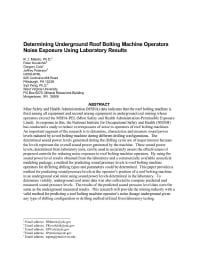Mining Publication: Determining Underground Roof Bolting Machine Operators Noise Exposure Using Laboratory Results
Original creation date: October 2007
Authors: RJ Matetic, PG Kovalchik, GP Cole, JS Peterson, SS Peng
NIOSHTIC2 Number: 20032797
NOISE-CON 2007, Reno, Nevada, October 22-24, 2007. Burroughs C; Hambric S; Conlon S; Maling G, eds., Ames, IA: Institute of Noise Control Engineering of the USA, 2007; :1-10
Mine Safety and Health Administration (MSHA) data indicates that the roof bolting machine is third among all equipment and second among equipment in underground coal mining whose operators exceed the MSHA-PEL (Mine Safety and Health Administration-Permissible Exposure Limit). In response to this, the National Institute for Occupational Safety and Health (NIOSH) has conducted a study to reduce overexposures of noise to operators of roof bolting machines. An important segment of the research is to determine, characterize and measure sound power levels radiated by a roof bolting machine during different drilling configurations. The determined sound power levels generated during the drilling cycle are of major interest because the levels represent the overall sound power generated by the machine. These sound power levels, determined from laboratory tests, can be used to accurately assess the effectiveness of proposed controls for reducing noise exposure to roof bolting machine operators. By using the sound power level results obtained from the laboratory and a commercially available acoustical modeling package, a method for predicting sound pressure levels to roof bolting machine operators for differing drilling types and parameters could be determined. This paper provides a method for predicting sound pressure levels at the operator’s position of a roof bolting machine in an underground coal mine using sound power levels determined in the laboratory. To determine validity, underground coal mine data was also collected to compare predicted and measured sound pressure levels. The results of the predicted sound pressure level data were the same as the underground measured results. This research will provide the mining industry with a valid method for predicting a roof bolting machine operator’s noise dosage underground given any type of drilling configuration or drilling method utilized from laboratory testing.

NIOSHTIC2 Number: 20032797
NOISE-CON 2007, Reno, Nevada, October 22-24, 2007. Burroughs C; Hambric S; Conlon S; Maling G, eds., Ames, IA: Institute of Noise Control Engineering of the USA, 2007; :1-10
- Analysis of a Mechanism Suspension to Reduce Noise from Horizontal Vibrating Screens
- Cross-Sectional Survey of Noise Exposure in the Mining Industry
- Limestone Mining: Is It Noisy or Not?
- A Noise Control for A Roof Bolting Machine: Collapsible Drill Steel Enclosure
- Noise Control in Underground Metal Mining
- Noise Exposure in Longwall Mining and Engineering Controls Research
- Sound Power Level Study of a Roof Bolter
- A Technique for Estimating the Sound Power Level Radiated by Pneumatic Rock Drills and the Evaluation of a CSIR Prototype Rock Drill with Engineering Noise Controls
- Underground Evaluation of Coated Flight Bars for a Continuous Mining Machine
- Water Well Safety Bits: Health And Safety Information For The Water Well Industry